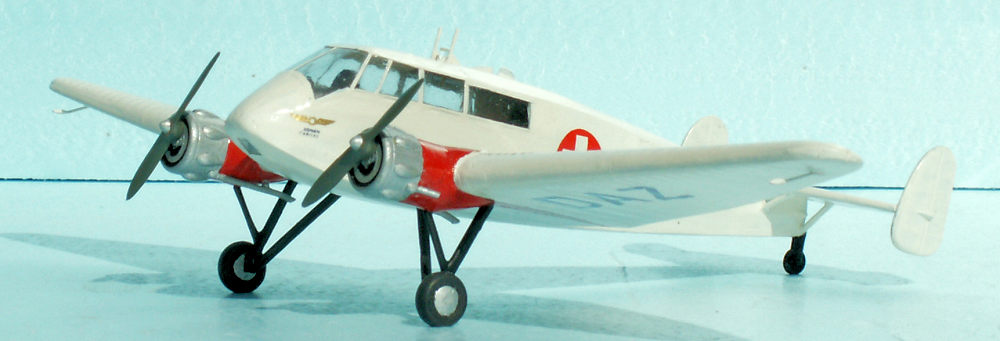
Azur 1/72 GAL ST-25 Monospar
| KIT #: | A034 |
| PRICE: | $28.00 |
| DECALS: | Three options |
| REVIEWER: | Torben Plesberg |
| NOTES: | Short run kit – Stoppel decals used for OY-DAZ ambulance plane |

| HISTORY |
The name Monospar refer to a special strong and light cantilever wing with a single main spar. The designations ST-1 and ST-2 were applied for two sets of the Monospar wings, the ST-2 was flight tested on a Fokker F. VII b-3m. The test was successful, and a complete aircraft with a Monospar wing was built, the ST-3. It was built by the Gloster Aircraft Ltd. on behalf of the Monospar Wing company and the ST-3 flew for the first time early in 1931. The flight performance was OK and a new company was formed to build further Monospar Aircraft: the General Aircraft Ltd.
The first aircraft produced by GAL was the ST-4, which was a twin engine fabric covered tubular steel construction. There was accommodation for four persons, and the ST-4 Monospar was powered by a couple of 85 hp. Pobjoy 7 cylinder radials. Six aircraft of this version was built. An improved version was the ST-4 mk. II, this aircraft had a built in landing light under the nose. Twenty four ST-4 mk. II aircraft were built, mostly for private owners.
The ST-6 was a five seater with enlarged cabin and a manually retractable main undercarriage, powered by 90 hp. Pobjoy Niagara radials. The Pobjoy radials do not have the propellers placed in the center as normally by radials. The propeller is placed in the top of the engine. The advantage of this position is that the propeller tips are well cleared off the ground, a good thing for take offs and landings on unprepared fields. Only two ST-6 were built, however, a third aircraft was converted from an ST-4 mk. II.
The next Monospar version was the ST-10 with a redesigned fuselage and taller cabin, more pointed nose and restyled fin and rudder. Only two were built, and one of these aircraft (G-ACTS) won the King’s Cup air race in July 1934 averaging 216 km/h.
The ST-11 was similar to the
ST-10, except for a manually retractable main undercarriage as the ST-6. Only
two planes were built and both were delivered for airline service in Australia.
The ST-12 was powered by two 130 hp. Gipsy Major in line engines, which offered
improved performance in spite of a higher gross weight. Newark Air Museum is
restoring a Monospar of this version, VH-UHT. In 1935, a single ST-18
 Croydon
was built. This was an enlarged version powered by two Pratt & Whitney 450 hp
Wasp radials and with accommodation for ten passengers and a cruising speed of
280 km/h. This aircraft was lost in October 1936 at the Great Barrier Reef on
its way from Australia to England.
Croydon
was built. This was an enlarged version powered by two Pratt & Whitney 450 hp
Wasp radials and with accommodation for ten passengers and a cruising speed of
280 km/h. This aircraft was lost in October 1936 at the Great Barrier Reef on
its way from Australia to England.
The final Monospar variant was the ST-25, which in fact was a development of the ST-10 with 90 hp Pobjoy Niagara II engines. The initial five-seat version was called the “Jubilee,” and entered service with some British airlines. Another version was the “De Luxe”, with four seats, 95 hp Niagara III engines and enlarged fin. Only two ”De luxe” Monospars were built. The second of these was converted to an air ambulance for the British Red Cross. The first “De Luxe” was converted to a “Universal” with twin fin and rudder tail assembly to improve stability with one engine shut down. Besides the outer wing panels could be folded backwards reducing the span to only 4.55 m. This was a practical measure, reducing the required space in a hangar. Twenty six “Universals” were built and several went into airline service in Canada, UK and Australia. In 1940 twenty civil registered Monospars of different versions were impressed for wartime service with the RAF.
The single Danish registered Monospar was a ST-25 Universal ambulance. The construction number was 95 and it was built in 1937. It flew for the first time 6-6-1937 at London Air Park piloted by Hollis Williams. The British registration was G-AEYF. Later the aircraft was used as a demonstrator aircraft in Budapest, Hungaria. 8-3-1939 pilot Williams delivered the aircraft in Kastrup Airport, and the following day the new flying ambulance was presented to the public, still in an all aluminum dope color scheme and carrying the British registration G-AEYF.
By 17-4-1939 the aircraft had been painted in the colors of “Zonens Flyvetjeneste” (Air Service of the Zone Rescue Corps) and got the Danish registration OY-DAZ and the name Caritas 1 (Charity 1). The active years as an ambulance plane lasted until 13-6-1948, when the plane was substituted by a Danish built SAI KZ-IV, which was similar to the Monospar, but of wooden construction, larger with room for two stretchers and two attendants. The last flight of the Monospar took place 18-5-1950, and the total flying time was only 592 hours and 5 minutes, a rather low figure.
In 1959, the Monospar was donated to the Royal Danish Aeroclub, a section of
which was working for the establishment of a Danish Aviation Museum. The
Monospar was stored in an old German hangar in the
 southern part of Kastrup
Airport. The wings were folded back and the aircraft only needed a small corner
for the storage. The birds in the hangar used the Monospar for their droppings,
and in 1966, the Monospar looked more like a camouflaged German night fighter,
as the chairman of the Aviation Historical Section put it.
southern part of Kastrup
Airport. The wings were folded back and the aircraft only needed a small corner
for the storage. The birds in the hangar used the Monospar for their droppings,
and in 1966, the Monospar looked more like a camouflaged German night fighter,
as the chairman of the Aviation Historical Section put it.
However, on a fine day in the spring 1966, it was the great cleaning day for the Monospar. It was pulled out of the hangar, and outside the wings were folded forward to flying position, and eight members of the Aviation Historical Section armed with brushes, soapy water and buckets did the job. The Monospar looked quite nice when the bird dropping camouflage was gone! The engine cowlings were rusty in some places and needed a renovation. At that time, the OY-DAZ was one of only two surviving Monospars in the world. The other one was in New Zealand with the same owner for fifty years, and still flying.
OY-DAZ was exhibited in the Egeskov Veteranmuseum at Egeskov Castle. One of the magazine buildings was in use for an impressive exhibition of veteran cars, motor bikes and aircraft. In 1980, the Monospar was moved from Egeskov Castle to Østerbrogade kaserne (Army Barracks) in Copenhagen. It was about time for a complete restauration of the aircraft, and in December 1987, this process was finished. In December 1989, the Monospar came to the exhibition building in the airport at Billund. This was the best possible exhibition of the aircraft: Standing on the ground and with the large stretcher door opened, and the stretcher on station in the cabin. The interior color of the cabin appeared to be a medium green, probably “ British interior green”.
However, the exhibition building got a financial problem, and in 1996 the Monospar was moved back to Egeskov Castle on exhibition for some years. Finally in 2005 the Monospar was moved to the Technical Museum in Elsinore – and it remains there to this day, hanging in some wires from the roof construction – not the best way of showing the aircraft, however, the very best way of showing the underside! See a picture of the OY-DAZ here.
| THE KIT |
The kit comes in a small box with a painting of one of the options on the top. The kit was designed in France, the tooling and molding was done in the Czech Republic. It first was released in 1997 and is a short run kit with two sprues in a light grey styrene, a small bag containing resin parts and two vacuum-formed clear canopies – one in reserve! The large parts fit well together, with no tabs and slots to secure a correct assembly. The centerlines of the engines do not correspond to the centerline of the fuselage as seen from the side. The engines are pulling downwards by approximately 9 degrees, and this is a flaw of the kit!
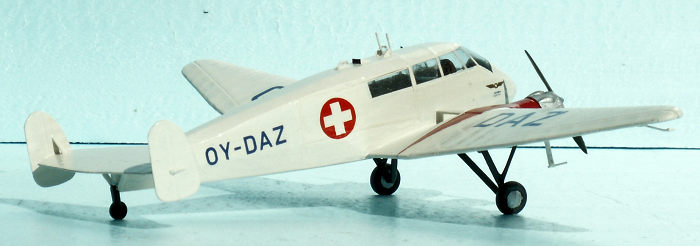 The instructions consists of eight A5 pages. Page one gives a short story of the
ST-25 Monospar in four languages: English, Czech, German and French. Page two
shows the sprues and the resin bars and the number of all the parts. Page three
to five show how to assemble the model, and pages six to eight show how to paint
and decal the three options.
The instructions consists of eight A5 pages. Page one gives a short story of the
ST-25 Monospar in four languages: English, Czech, German and French. Page two
shows the sprues and the resin bars and the number of all the parts. Page three
to five show how to assemble the model, and pages six to eight show how to paint
and decal the three options.
There are three options for the tail assembly: parts A 9, 10, 11, 15, 18 and 19 are for the twin fin and rudder of the ST-25 Universal. Parts A- 13 and 14 are for the early variants, ST-4 to St-12, and part A 12 is for the St-25 De Luxe. The tail wheel A- 4 is too small and should be in the least 50 % larger.
The decal sheet looks very well printed, but I can’t tell how it works when being applied, since I did not use them.
Important is to know, that the dihedral shown on the sketch page 4 in the instructions is incorrect. The wing tips must be 2 mm higher up, corresponding to 4 mm on the model, since the sketch is to a 1/144 scale. A characteristic feature of the Monospar is even its rather large dihedral!
| CONSTRUCTION |
If you follow the instructions, you should end up with a nice replica of the
real thing. However, the kit has a serious flaw: both engines are tilted
downwards by about 9 degrees compared to the longitudinal axis of the fuselage!
I got aware of the problem after the assembly of the wings to the fuselage. At
this stage of construction I compared the model with my photos of the real
thing, and it was easy to see, what was
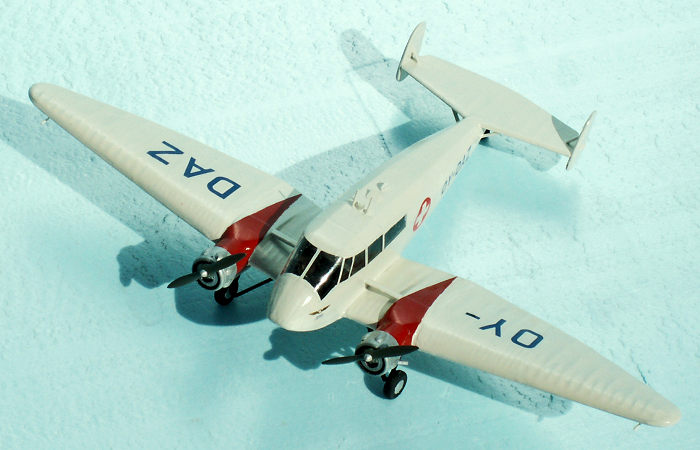 wrong. Of course, this problem should be
taken care of when the wings are assembled, and before they are glued to the
fuselage. The way I did this correction was a bit more troublesome, because I
found it easier to paint the wings and fuselage before the assembly, and the
wings were glued to the fuselage.
wrong. Of course, this problem should be
taken care of when the wings are assembled, and before they are glued to the
fuselage. The way I did this correction was a bit more troublesome, because I
found it easier to paint the wings and fuselage before the assembly, and the
wings were glued to the fuselage.
This is how I did: First thing to do was to cut off the engines as close to the wings as possible – and without touching the wings with the razor saw blade. Next thing to do was to produce two 8.3 mm gauge wedges, thickness 0.0 mm in the top and 0.9 mm in the bottom. These wedges will deal perfectly with the tilting problem.
Now I glued the wedges in place on the cowling stubs using super glue. This operation must be done very carefully. The engine cowlings are not perfectly circular as the wedges are, and some filling and sanding is necessary to get a perfect alignment of the wedges to the cowlings. This correction was a challenge, and if you don’t have a small lathe and a small circular saw to produce the custom wedges, it might be rather difficult – but not impossible – to correct the engine tilting.
The other challenge was to cut the vacuum-formed canopy to fit the opening in the fuselage exactly. The windows of the canopy of OY-DAZ are not standard, because it is an ambulance plane. There is no glazing in the roof and the rear windows should not be there. Since the glazing is sparse compared to a normal Monospar, I found it not necessary to detail the interior. Nothing of the interior is visible from the outside anyway. On the other hand, I found it much more important to make a proper framing of the glazing. All frames are thinner than one mm, but they are clearly visible on the very dark background of the interior. The right size of the frames are important for the right look of the model.
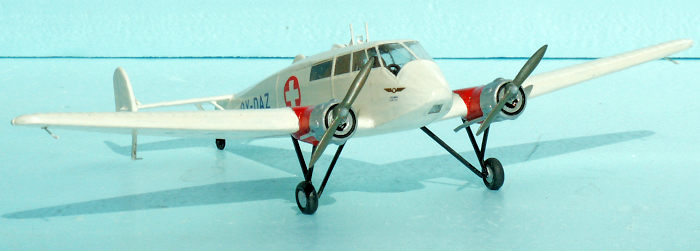 The nose mounted landing light is not with the kit, but it is a characteristic
detail of the Monospar Universal and I had to scratch build this item. The light
was a 2.5 mm gauge disc punched from a piece of a self-adhesive metal sticker. I
cut a trapezoid shaped opening under the nose. As a base for the disc, a small
piece of plastic card was glued perpendicular to the longitudinal axis of the
fuselage, and finally I cut a small piece of clear 0.3 mm acryl to fit the
trapezoid opening.
The nose mounted landing light is not with the kit, but it is a characteristic
detail of the Monospar Universal and I had to scratch build this item. The light
was a 2.5 mm gauge disc punched from a piece of a self-adhesive metal sticker. I
cut a trapezoid shaped opening under the nose. As a base for the disc, a small
piece of plastic card was glued perpendicular to the longitudinal axis of the
fuselage, and finally I cut a small piece of clear 0.3 mm acryl to fit the
trapezoid opening.
The dihedral shown on the sketch page 4 in the instructions is incorrect. The wing tips should be elevated a further two mm, this is equal to four mm on the model, since the sketch is half scale: 1/144.
The tail wheel is too small. The gauge should be 3.5 mm and the distance between the end of the rear fuselage and the ground should be 5.5 mm – just to get the right slope of the fuselage rearwards. I found a suitable tail wheel in my stocks. However, the gauge was 5 mm, and I sanded the wheel down to 3.5 mm.
Gluing the wings properly to the fuselage needs a couple of one mm brass pins to secure a correct and strong fastening. It is easy to drill the holes for the pins in the fuselage stub. In the wings, it is difficult to make the holes exactly corresponding to the holes in the fuselage. However, it is easy to “move” the holes in any direction using a thin circular needle file.
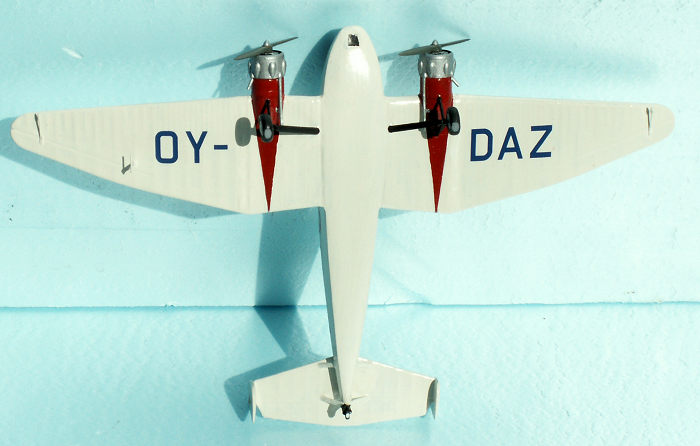 To get the dihedral right a jig might be a good idea. The meaning of a jig is,
that it eliminates the impact of the gravity and thus secures that the dihedral
will not change during the setting of the glue. However, a template showing the
dihedral is sufficient as reference for obtaining a correct dihedral. To avoid
the influence of the gravity, it is a good idea to fix the fuselage in a
vertical position, and the dihedral will remain as you set it.
To get the dihedral right a jig might be a good idea. The meaning of a jig is,
that it eliminates the impact of the gravity and thus secures that the dihedral
will not change during the setting of the glue. However, a template showing the
dihedral is sufficient as reference for obtaining a correct dihedral. To avoid
the influence of the gravity, it is a good idea to fix the fuselage in a
vertical position, and the dihedral will remain as you set it.
The door for the stretcher room in the cabin was made of some stripes of 0.6 mm Tamiya tape. Another detail added was the two antenna holders on the roof of the cabin. Only apply the exhausts of the kit on the inner positions. The exhausts on the outer positions are just 0.5 mm gauge tubes, about three mm long. However this might not be correct, compared to a photo of the ZK-AFF, the last Monospar in New Zealand. The OY-DAZ is a restored aircraft, and some details might have failed, simply because the parts were not available or the funds were not sufficient to reproduce them. On the roof of the cabin, there is a small beacon and an air outlet from the cabin. Under the outer wings, there is a balance weight for the ailerons, and under the starboard wing, there is a pitot tube.
| COLORS & MARKINGS |
The overall color scheme of the OY-DAZ is off-white. There are red wedges on the
wings from behind the cowlings –both on the upper-sides and undersides. The
cowlings, exhaust pipes and spinners are
 aluminum, the propellers dark green.
The undercarriage legs and struts are black, and so is the tail wheel assembly.
I used the following colors: Revell Aqua 05 matt white (which in fact is a
little off-white), 31 fire red gloss, 99 Aluminum metallic, clear gloss 01, and
Model Master 4888 flat engine black, and RLM 71 dark green. I applied the clear
gloss 01 before decaling and as the final finish of the model. This varnish is
also perfect for fixing transparent parts to the airframe. It also improves the
finish of the canopy. The matt white is the best choice for the framing of the
canopy, since the paint will not peel off when removing the masking tape.
aluminum, the propellers dark green.
The undercarriage legs and struts are black, and so is the tail wheel assembly.
I used the following colors: Revell Aqua 05 matt white (which in fact is a
little off-white), 31 fire red gloss, 99 Aluminum metallic, clear gloss 01, and
Model Master 4888 flat engine black, and RLM 71 dark green. I applied the clear
gloss 01 before decaling and as the final finish of the model. This varnish is
also perfect for fixing transparent parts to the airframe. It also improves the
finish of the canopy. The matt white is the best choice for the framing of the
canopy, since the paint will not peel off when removing the masking tape.
I used a special Stoppel Decal Sheet for Monospar OY-DAZ. It works well, and the single decals are easy to apply. The carrier film is rather thin – be careful when pressing the water away!
| CONCLUSIONS |
The Monospar ST-25 Universal is a neat little twin engine aircraft. It is very special and does not look like any other aircraft. In spite of the flaws of the kit, it is possible with some effort to make a convincing replica of the real thing: The only surviving Monospar Universal in the world, once the first Danish ambulance plane. The Azur kit is recommend for experienced modelers, not for beginners.
| REFERENCES |
Kenneth Munson: Airliners from 1919 to the Present Day. Peerage Books 1975. ISBN 0 90 7408 36 2
The development from ST-1 to ST-25 Monospar.
Wikipedia: General aircraft Monospar ST-25
My own photos of OY-DAZ from Kastrup Airport 1962 and 1966 - and from Technical Museum 2011.
The home page of Zonens Redningskorps: zoneredningskorpset.dk
3 May 2018
Copyright ModelingMadness.com
If you would like your product reviewed fairly and fairly quickly, please contact the editor or see other details in the Note to Contributors.